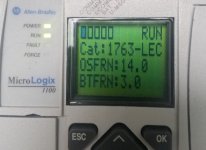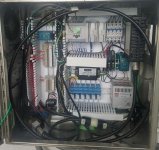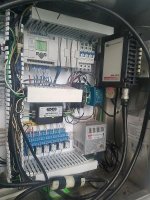Before I start, I'll introduce myself. I'm a lab nerd who has some IT background and I've been roped into trying to help figure out what's going on with a PLC...which until about 3 months ago, I didn't know anything about...I still don't know much. I did manage to figure out how to get a copy of RSLogix Micro and RSLinx Classic going on my laptop and I've used it to download a program to the Micrologix 1100. I don't know anything about programming PLCs but I'm willing to learn whatever I can!
What I've got is a Micrologix 1100 that keeps ending up in fault and someone keeps clearing the fault before I can get to it to find out what's going on. Well today I was able to get the fault. The display read "Major Error Code=0022h" The PLC is being used with SCADA to control 2 pumps and receive some flow information from a radio and pass it along to SCADA. When it hangs up, the pumps stop and the flow data from the radio also hangs.
This keeps happening but not in a set frequency. I've attached the program for you to look over. I've got 2 of the Micrologix 1100s, one on my desk to play with and one online in the field.
Thanks in advance for your patience and time!
Tom
What I've got is a Micrologix 1100 that keeps ending up in fault and someone keeps clearing the fault before I can get to it to find out what's going on. Well today I was able to get the fault. The display read "Major Error Code=0022h" The PLC is being used with SCADA to control 2 pumps and receive some flow information from a radio and pass it along to SCADA. When it hangs up, the pumps stop and the flow data from the radio also hangs.
This keeps happening but not in a set frequency. I've attached the program for you to look over. I've got 2 of the Micrologix 1100s, one on my desk to play with and one online in the field.
Thanks in advance for your patience and time!
Tom





